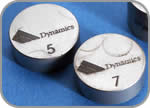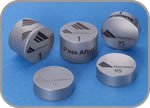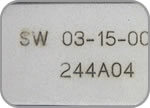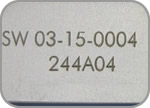Corrosion Resistant Laser Marking
NLE's Corrosion Resistant Process survives passivating and passes ASTM F1089-02 (Standard Test Method for Corrosion of Surgical Instruments) on 304, 316, 455, 17-4 and 17-7 stainless steels!
Previously, a major disadvantage of laser marking or laser engraving in the medical industry was the tendency for the marking to rust, especially on reusable, autoclaveable instruments made from stainless steels. The laser process tended to create markings that would fade during passivation and/or corrode after several autoclave cycles. In 1999, Northeast Laser saw this as an opportunity to identify the cause and develop a solution to this challenging problem. The result (of over a year of research) was NLE's proprietary Corrosion Resistant Process, which has proven effective on 304, 316, 455, 17-4 and 17-7 stainless steels.
Though others claim to offer corrosion resistant marking, we urge you to compare. The samples below show our corrosion resistant process up against a competitor's marking on a 304 stainless steel surgical component. After only 3 autoclave cycles, the competitor's mark is already "bleeding" and chipping, while the NLE's marking remains clear and corrosion free. (click on the photo for enlarged views).
On 17-4, which has an even greater tendency to corrode, the results are impressive. The 17-4 stainless steel slugs in the photo below were marked with NLE's proprietary Corrosion Resistant Process, while the slugs in the lower photo were marked with typical settings. Both sets of samples were subjected to 50 autoclave cycles, as well as the ASTM F1089-02 Boil Test and Copper Sulfate Corrosion Test. The results are quite dramatic. This proprietary process survives passivation and passes ASTM F1089-02 (Standard Test Method for Corrosion of Surgical Instruments) on 304, 316, 17-4 and 17-7 stainless steels.
NLE has been providing this service for over fifteen years, with outstanding success in the field. More and more medical device manufacturers call out NLE's Corrosion Resistant marking process, due to our proven results. Give NLE a call with your medical component application. We'd be happy to provide you with samples of our corrosion resistant marking in order for your company to see how effective our proprietary process can be. NLE's Corrosion Resistant process can be performed on both flat and curved surfaces.




























